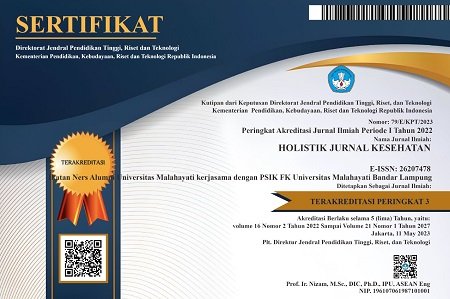Perbedaan pengaruh peregangan dan pemulihan pasif terhadap kadar asam laktat: A scoping review
Abstract
Background: Humans are living creatures who always carry out physical activity to fulfill their needs. After physical activity, an increase in metabolites such as lactic acid (LA) can reduce muscle cell vitality, affect enzyme activity and reduce energy production, resulting in fatigue. The impact of fatigue can result in decreased motivation and increased stress. This situation can influence performance to decrease.
Purpose: Identify gaps and make suggestions about the effect of stretching as active recovery or passive recovery on fatigue.
Method: The author used the PRISMA checklist to guide the scoping review. The databases used are Scopus, ScienceDirect, ProQuest, EBSCOhost, SpringerLink, Pubmed, JSTORE, Willey Online, Google Scholar to search for academic articles published in English between 2013 and 2023 that meet predetermined content criteria regarding the effect of stretching as active recovery or passive recovery of lactic acid levels. The process of selecting evidence sources based on screening and suitability of evidence from initially 24,116 sources of evidence identified in the search database was reduced to seventeen sources of evidence. The contents of these sixteen sources of evidence are mapped on charting tables where the data are summarized and synthesized first individually and then collectively by the authors. Repetitive and irrelevant data were collectively removed by the authors from the charting tables.
Results: The findings of a scoping review from various research results that have been carried out previously stated that stretching as an active recovery is more effective in reducing lactic acid levels than passive recovery.
Conclusion: The gap identified is the lack of research that focuses specifically on workers, even though their population in the world is larger than athletes. The research methodology (data collection and data analysis) of the article only includes quantitative methods, not accompanied by qualitative methods (mixed methods). Future research directions are suggested and limitations of this scoping review are also discussed.
Keywords: Lactic Acid; Motivation; Muscle Cell Vitality; Physical Activity
Pendahuluan: Manusia merupakan makluk hidup yang selalu melakukan aktivitas fisik untuk memenuhi kebutuhan mereka. Setelah aktivitas fisik, terjadi peningkatan metabolit seperti asam laktat (LA) dapat menurunkan vitalitas sel otot, mempengaruhi aktivitas enzim dan dan mengurangi produksi energi, mengakibatkan kelelahan. Dampak dari terjadinya kelelahan dapat berpengaruh terhadap motivasi yang menurun, dan stress yang semakin meningkat. Keadaan tersebut dapat mempengaruhi kinerja yang semakin menurun.
Tujuan: Mengidentifikasi kesenjangan dan membuat saran tentang pengaruh pemberian peregangan sebagai recovery aktif maupun melakukan recovery pasif terhadap kelelahan.
Metode: Penulis menggunakan daftar periksa PRISMA untuk memandu melakukan scoping review. Basis data yang digunakan yaitu Scopus, ScienceDirect, ProQuest, EBSCOhost, SpringerLink, pubmed, JSTORE, Willey Online, Google Scholar untuk mencari artikel akademik yang diterbitkan dalam Bahasa Inggris antara tahun 2013 dan 2023 yang memenuhi kriteria konten yang telah ditentukan tentang pengaruh pemberian peregangan sebagai recovery aktif maupun melakukan recovery pasif terhadap kadar asam laktat. Proses pemilihan sumber bukti berdasarkan penyaringan dan kelayakan bukti yang awalnya 24.116 sumber bukti teridentifikasi dalam database pencarian berkurang menjadi tujuh belas sumber bukti. Isi dari enam belas sumber bukti ini dipetakan pada tabel charting di mana data dirangkum dan disintesis pertama secara individual dan kemudian secara kolektif oleh penulis. Data berulang dan tidak relevan telah dihapus secara kolektif oleh penulis dari tabel charting.
Hasil: Temuan scoping review dari berbagai hasil penelitian yang telah dilakukan sebelumnya menyebutkan bahwa peregangan sebagai recovery aktif lebih efektif menurunkan kadar asam laktat daripada recovery pasif.
Simpulan: Kesenjangan yang diidentifikasi adalah kurangnya penelitian yang memfokuskan secara khusus kepada pekerja, padahal poulasinya di dunia lebih banyak daripada atlet. Metodologi penelitian (pengumpulan data dan analisis data) dari artikel hanya mencakup metode kuantitatif tidak dibarengi dengan metode kualitatif (metode campuran). Arahan penelitian selanjutnya telah disarankan dan batasan scoping review ini juga dibahas.
Keywords
References
Appleton, B. (1998). Stretching and flexibility. USA: Apleton Inc.
Arianto, P., & Dwiyanti, E. (2020). Subjective Work Fatigue Due to Hot Work Climate (A Study on Indoor Production Workers of Ud King Rack Surabaya Indonesia). Indian Journal of Forensic Medicine & Toxicology, 14(2). doi:10.37506/ijfmt.v14i2.3237
Astuti, S. J., & Koesyanto, H. (2016). Pengaruh Stretching Terhadap Nyeri Punggung Bawah dan Lingkup Gerak Sendi Pada Penyadap Getah Karet PT Perkebunan Nusantara IX (Persero) Kendal. Unnes Journal of Public Health, 5(1), 1-9. doi:10.15294/ujph.v5i1.9698
Bassett, D. R., & Howley, E. T. (2000). Limiting factors for maximum oxygen uptake and determinants of endurance performance. Medicine and science in sports and exercise, 32(1), 70-84.
Cè, E., Limonta, E., Maggioni, M. A., Rampichini, S., Veicsteinas, A., & Esposito, F. (2013). Stretching and deep and superficial massage do not influence blood lactate levels after heavy-intensity cycle exercise. Journal of sports sciences, 31(8), 856-866. doi:10.1080/02640414.2012.753158
Choi, D., Cole, K. J., Goodpaster, B. H., Fink, W. J., & Costill, D. L. (1994). Effect of passive and active recovery on the resynthesis of muscle glycogen. Medicine and science in sports and exercise, 26(8), 992-996.
Corder, K. P., Potteiger, J. A., Nau, K. L., Figoni, S. E., & Hershberger, S. L. (2000). Effects of active and passive recovery conditions on blood lactate, rating of perceived exertion, and performance during resistance exercise. The Journal of Strength & Conditioning Research, 14(2), 151-156. doi:10.1519/00124278-200005000-00006
Danardono, H. (2013). Perbedaan Pengaruh Jenis Recovery Aktif, Corstability, Dan Pasif, Sesudah Latihan Maksimum Terhadap Penurunan Kadar Asam Laktat Ditinjau Dari Indeks Massa Tubuh (Doctoral dissertation, UNS (Sebelas Maret University)).
Dewita, T. (2018). Pengaruh stretching terhadap penurunan kadar asam laktat pada pekerja bagian produksi PT. X. XNo Title. J Kreat Ind, 2(2). doi:10.36352/jik.v2i2.124
Gisolfi, C., Robinson, S., & Turrell, E. S. (1966). Effects of aerobic work performed during recovery from exhausting work. Journal of Applied Physiology, 21(6), 1767-1772. doi:10.1152/jappl.1966.21.6.1767
Gossec, L., Walsh, J. A., Michaud, K., Holdsworth, E., Peterson, S., Meakin, S., & Ogdie, A. (2022). Effect of fatigue on health-related quality of life and work productivity in psoriatic arthritis: findings from a real-world survey. The Journal of rheumatology, 49(11), 1221-1228. doi:10.3899/jrheum.211288
Haetami, M., & Triansyah, A. (2021). The effect of massage and active streching on speeding up blood lactic acid recovery. Halaman Olahraga Nusantara (Jurnal Ilmu Keolahragaan), 4(2), 326-338. doi:10.31851/hon.v4i2.5572
Hinzpeter, J., Zamorano, Á., Cuzmar, D., Lopez, M., & Burboa, J. (2014). Effect of active versus passive recovery on performance during intrameet swimming competition. Sports health, 6(2), 119-121. doi:10.1177/1941738113500769
Ihsan, T., Edwin, T., Azwir, Y., & Derosya, V. (2020). Fatigue analysis to evaluate workloads in production area at crumb rubber factories of Padang city, West Sumatra Indonesia. Indian Journal of Occupational and Environmental Medicine, 24(3), 148.
Jafari, R. A. (2021). Responses of blood lactate concentration, heart rate, and blood pressure using three active recovery methods versus passive recovery after an exhaustive exercise in young elite wrestlers. Journal of Exercise and Health Science, 1(2), 35-54.
Khan, S., & Bandyopadhyay, N. A. (2016). Comparative Study of Different Recovery Programmes on Blood Lactate Removal. Progressive, 12(3.18), 0-82. doi:10.21275/v5i5.nov164012
Kodrat, K. F. (2011). Pengaruh shift kerja terhadap kelelahan pekerja pabrik kelapa sawit di PT. x Labuhan Batu. Jurnal Teknik Industri, 12(2), 110-117.
Kosar, A. C., Candow, D. G., & Putland, J. T. (2012). Potential beneficial effects of whole-body vibration for muscle recovery after exercise. The Journal of Strength & Conditioning Research, 26(10), 2907-2911. doi:10.1519/JSC.0b013e318242a4d3
Kurniawan, B., Rahfiludin, Z., Setyaningsih, Y., & Nurjazuli, N. (2022). Ergonomic Risk, Muscle Tension, Lactic Acid, and Work Performance on Transport Workers at Fish Auction. Media Kesehatan Masyarakat Indonesia, 18(2), 50-56. doi:10.30597/mkmi.v18i2.19739
Kusumawardhana, B. (2018). Perbandingan Metode Recovery Aktif dan Metode Corstability terhadap Kadar Asam Laktat. JSES: Journal of Sport and Exercise Science, 1(2), 62-67.
Maharja, R. (2015). Analisis tingkat kelelahan kerja berdasarkan beban kerja fisik perawat di instalasi rawat inap RSU Haji Surabaya. The Indonesian Journal of Occupational Safety and Health, 4(1), 93-102.
Menzies, P., Menzies, C., McIntyre, L., Paterson, P., Wilson, J., & Kemi, O. J. (2010). Blood lactate clearance during active recovery after an intense running bout depends on the intensity of the active recovery. Journal of sports sciences, 28(9), 975-982. doi:10.1080/02640414.2010.481721
Mika, A., Oleksy, Ł., Kielnar, R., Wodka-Natkaniec, E., Twardowska, M., Kamiński, K., & Małek, Z. (2016). Comparison of two different modes of active recovery on muscles performance after fatiguing exercise in mountain canoeist and football players. PloS one, 11(10), e0164216. doi:10.1371/journal.pone.0164216
Mokayef, M., & Shahini, P. (2017). Comparison of contrast water immersion, active recovery and passive recovery on blood lactate and CRP levels in table tennis players. Journal of Physical Activity and Hormones, 1(2), 17-28. http://www.iaujournals.ir/article_532181.html
Ningrum, D. (2012). Perbandingan Metode Hydrotherapy Massage dan Massage Manual Terhadap Pemulihan Kelelahan Pasca Olahraga Anaerobic Lactacid (Doctoral dissertation, Universitas Pendidikan Indonesia).
Ningsih, Y. F., & Puspitaningrum, D. A. (2018, November). Efektivitas Stretching Aktif Dan Stretching Pasif Dalam Pemulihan Asam Laktat Darah Dan Denyut Jantung Setelah Lari Cepat 400 Meter. In Prosiding Seminar Nasional IPTEK Olahraga (SENALOG) (Vol. 1, No. 1, pp. 50-54).
Özsu, İ., Gurol, B., & Kurt, C. (2018). Comparison of the Effect of Passive and Active Recovery, and Self-Myofascial Release Exercises on Lactate Removal and Total Quality of Recovery. Journal of Education and Training Studies, 6(n9a), 33-42.
Perdana, R. G., & Sahroni, T. R. (2019). Analysis of human and ergonomic factor influence for preventing major accident in offshore oil and gas industry. International Journal of Mechanical Engineering and Technology, 10(2), 1620-1628.
Popp, J. K., Bellar, D. M., Hoover, D. L., Craig, B. W., Leitzelar, B. N., Wanless, E. A., & Judge, L. W. (2017). Pre-and post-activity stretching practices of collegiate athletic trainers in the United States. The Journal of Strength & Conditioning Research, 31(9), 2347-2354.
Rahardja, A. T. (2004). Hubungan Antara Komunikasi antar Pribadi Guru dan Motivasi Kerja Guru dengan Kinerja Guru SMUK BPK PENABUR Jakarta. Jurnal Pendidikan Penabur, 3(3), 1-21.
Rahman, A. (2018). Pengaruh teknik relaksasi benson terhadap gula darah pasien DM tipe II.
Russeng, S. S., Saleh, L. M., Virani, D., Latief, A. W. L., & Mallongi, A. (2018). The Investigation of the Lactic Acid Change among Employee of National Electrical Power Plan. Indian Journal of Public Health Research & Development, 9(1). doi:10.5958/0976-5506.2018.00067.0
Santillo, N. (2016). The comparative effect of recovery interventions on blood lactate removal post-high intensity kettlebell training session (Doctoral dissertation, The William Paterson University of New Jersey).
Setiawan, M. A., Awaluddin, A. W., & Tualeka, A. R. (2020). Factors associated with work fatigue in workers of the Nipah building construction project Makassar. Indian Journal of Public Health Research & Development, 11(1), 1289-1293. doi:10.37506/v11/i1/2020/ijphrd/194020
Shubao, L., & Dong, H. (2023). Relaxation effects on fatigue and physical fitness in badminton athletes. Revista Brasileira de Medicina do Esporte, 29, e2023_0023.
Takahashi, J., Ishihara, K., & Aoki, J. (2006). Effect of aqua exercise on recovery of lower limb muscles after downhill running. Journal of sports sciences, 24(8), 835-842. doi:10.1080/02640410500141737
Taoutaou, Z., Granier, P., Mercier, B., Mercier, J., Ahmaidi, S., & Prefaut, C. (1996). Lactate kinetics during passive and partially active recovery in endurance and sprint athletes. European journal of applied physiology and occupational physiology, 73(5), 465-470. doi:10.1007/BF00334425
Tricco, A. C., Lillie, E., Zarin, W., O'Brien, K. K., Colquhoun, H., Levac, D., & Straus, S. E. (2018). PRISMA extension for scoping reviews (PRISMA-ScR): checklist and explanation. Annals of internal medicine, 169(7), 467-473. doi:10.7326/M18-0850
Warren, C. D., Szymanski, D. J., & Landers, M. R. (2015). Effects of three recovery protocols on range of motion, heart rate, rating of perceived exertion, and blood lactate in baseball pitchers during a simulated game. The Journal of Strength & Conditioning Research, 29(11), 3016-3025.
West, A. D., Cooke, M. B., LaBounty, P. M., Byars, A. G., & Greenwood, M. (2014). Effects of G-trainer, cycle ergometry, and stretching on physiological and psychological recovery from endurance exercise. The Journal of Strength & Conditioning Research, 28(12), 3453-3461.
Wibowo, T., Sukaryawan, I. M., & Hatmoko, J. U. D. (2020, September). Identifying Causal Factors of Accidents Related to Working at Height: A Case Study of a Construction Company. In Proceedings of the 2021 International Conference on Engineering and Information Technology for Sustainable Industry (pp. 1-7).
Widiyanto, A., Panuluh, S. M., Pradana, K. A., Mubarok, A. S., Atmojo, J. T., Putra, N. S., & Panatagama, S. P. (2021). Literatur Review: Efektivitas Teknik Relaksasi Nafas Dalam (Deep Breathing Relax) Pada Ibu Bersalin Kala I. Avicenna: Journal of Health Research, 4(2).
Yenni, M., Husaini, A., & Wuni, C. (2020, October). Efektifitas latihan peregangan terhadap penurunan kadar asam laktat pada pekerja di PT. Angkasa Raya Djambi. In Jurnal Formil (Forum Ilmiah) KesMas Respati e-ISSN (Vol. 5, No. 2, pp. 147-160).
Zhang, H., Liu, Y., Zhou, J., Wang, J., & Sun, B. (2014). Amylopectin is the anti-fatigue ingredient in glutinous rice. International journal of biological macromolecules, 63, 240-243.
Zhu, M., Zhu, H., Ding, X., Liu, S., & Zou, Y. (2020). Analysis of the anti-fatigue activity of polysaccharides from Spirulina platensis: role of central 5-hydroxytryptamine mechanisms. Food & function, 11(2), 1826-1834.
Zulaini, Z., Harahap, N. S., Siregar, N. S., & Zulfahri, Z. (2021). Effect Stretching and Recovery on Delayed Onset Muscle Soreness (DOMS) After Exercise. In Journal of Physics: Conference Series (Vol. 1811, No. 1, p. 012113). IOP Publishing. doi:10.1088/1742-6596/1811/1/012113
DOI: https://doi.org/10.33024/hjk.v17i6.12412
Refbacks
- There are currently no refbacks.
Copyright (c) 2023 Holistik Jurnal Kesehatan

This work is licensed under a Creative Commons Attribution-NonCommercial 4.0 International License.














